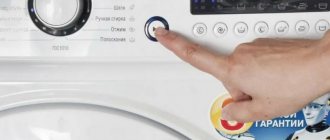What affects washing time?
An automatic washing machine, performing a full cycle, goes through certain stages:
- Pre- and main wash.
- Rinsing.
- Spin.
What determines the duration of the cycle of each stage? Let's figure it out:
- Temperature selection.
If you select the high temperature option, the heating element will take longer to heat the water. This increases the waiting time. To shorten the cycle, choose a quick wash at 30 degrees or cold water. - How long does it take to rinse in a washing machine? Depends on the choice of options. When you choose an extra rinse, the cycle can extend to 20-30 minutes.
- Spin speed. Do you want to get almost dry laundry out of the tank, so you choose high spin speeds? This choice at 800 rpm will cost you 10 minutes of waiting. And if you set it to 1000, then at least 15 minutes.
- For heavily soiled items, users choose an additional (preliminary) mode or soaking. How long does pre-wash last? It will take 25-30 additional minutes.
- Expensive SMAs equipped with smart sensors independently determine the weight and degree of soiling of the laundry. So, the machine selects the optimal time mode for high-quality washing.
What temperature to choose for washing different types of fabric
When choosing a washing temperature, it is best to follow the information on the product label. However, if this is not possible, you can follow the general rules.
- items made of natural wool (both 100% and with the addition of cotton or synthetics) are washed at a minimum temperature of 20-30 degrees;
- clothes and linen made of silk and items with lace trim also require special delicacy; the recommended water temperature for washing is 30°C;
- items made of viscose silk require the same careful handling as natural silk; the water temperature for washing should not exceed 30°C;
- tulle curtains are washed at 30-40 degrees;
- lavsan, lycra, nylon and nylon are less demanding on temperature - the fibers can withstand temperatures up to 50-60°C, and chemical bleaches cannot be used for washing them. These restrictions also apply to items made from natural fibers with the addition of synthetics - even if the content of, for example, lavsan is 5%, if the permissible temperature is exceeded, the item may become deformed;
- fabrics made from 100% cotton, linen or jute can be washed at any temperature, however, it is not recommended to expose brightly colored fabric to very hot water - if systematically washed at temperatures above 60°C, even the most durable color will quickly fade;
- sportswear (fleece, thermal underwear, clothes made from membrane fabrics) are washed as carefully as possible, at a temperature of 30°C and using special products;
- jeans are washed at 30-40 degrees, this avoids deformation of the product and preserves the color of the fabric;
- Down jackets and clothes lined with synthetic padding are also washed at low temperatures - from 30 to 40 degrees.
Basic modes
Washing machines, regardless of the country of manufacture and brand, are programmed for basic automatic operation modes. They are triggered by placing switches in certain positions.
You can select them based on the icons or labels on the control panel. The washing machine can perform washing modes using the following software algorithms:
| Name | Contents of the process |
| Cotton | Used for wardrobe items, bedding, cotton fabrics. The preset temperature is 950C, the spin speed of the drum is maximum. What distinguishes the Intensive mode from the “clap” position is the cycle time. For lightly colored items, you can reduce the temperature and spin speed. |
| Synthetics | Recommended for products made from synthetic fabrics. Temperature 40-600C. Maximum spin. It is possible to measure heating and spin parameters. |
| Wool | The temperature does not exceed 400C. Spinning is performed at minimized speed. When performing a cycle, the drum is filled with water and “swings”. Loading does not exceed 1/3 of the volume declared by the manufacturer. |
| Baby clothes | High temperature, as with the Cotton program. The difference is represented by an increased rinsing time to remove all detergent elements. |
| Quick wash | The fastest washing mode. It is also called “hand wash” or “daily wash”. The water temperature is within 300C. Cycle time is from 30-45 minutes. Some machine models do not provide spinning. Used to remove minor stains. |
| Delicate | Similar to the manual cycle with a higher temperature. They clean not only clothing items, but also wardrobe items. The main cycle modes differ little from the “hand wash” position. |
| Intensive | You should know in more detail what intensive washing in a washing machine is and what the differences are. It is used for contaminated items. The intensive wash time is within 90-60 minutes. Heating up to 900C. Push-ups at maximum speed. |
| Preliminary (soaking) | The washing time in the washing machine is maximum as several operations are performed. Cycle 60-120 minutes. Used to clean heavy stains using stain removers, bleaches and detergents. When using the program, the third loading tray is used. |
Recommendations for operating an automatic washing machine and setting a washing program are presented in the following video:
Expert advice
In order to improve the quality of washing, as well as not to damage the automatic washing machine and preserve washable items, it is recommended to observe the following measures:
- do not overload the drum, as this may lead to damage to the machine;
- shake out coins and other foreign objects from clothing pockets;
- distribute products according to color and type of fabric from which they are made;
- wash items of different sizes together to improve the quality of washing;
- turn terry and knitted items inside out so that the pellets from their surface do not settle on other items;
- fasten zippers and buttons on clothes;
- Follow the norms for loading detergents and the drum.
A correctly selected washing program and the desired mode will not only allow you to better wash the product and extend its service life, but also rationally use electricity, water and detergents.
Video
What determines the duration of washing?
So, what can cause your washing time to increase (or decrease if you skip these steps):
- water temperature - the hotter it is, the longer it takes to heat it. Washing in cold water (30 degrees or less) is at least 10-15 minutes faster than in boiling water (80-90 degrees),
- turning on the pre-wash or additional wash mode. This will add a quarter of an hour to the main mode,
- modern machines even allow you to soak laundry, but this is also extra time (at least 1/3 of an hour),
- additional rinsing adds up to half an hour to the main washing time,
- spin mode. At high speeds (1000) it takes an average of 15 minutes to dry clothes, at lower speeds - faster - within 10 minutes,
- boiling laundry also takes extra time, at least to heat the water to the required temperature,
- use of intelligent modes. Modern machines are able to vary programs depending on the weight of the laundry and the degree of soiling. The larger the load, the longer the device will work. It’s the same with stains: the stronger they are, the more of them, the longer the wash will be,
- model and age of the machine. Modern devices are faster and more economical. With older machines, even a quick wash can take 40 minutes.
LG washing machine
Similar devices from the LG brand are equipped with a program that is suitable for synthetic things. It may also be called Everyday Wash. The option is suitable for clothing made from acrylic, nylon and polyamide. Features of the program are that heating reaches only 40 degrees Celsius. Due to this, it is possible to avoid shedding and stretching.
Cycle times may vary depending on the situation. If you do not change the settings, then the wash will last 70 minutes. This mode is convenient for synthetic items, because it does not spoil them and cleans them well.
What determines the duration of washing?
So, what can cause your washing time to increase (or decrease if you skip these steps):
- water temperature - the hotter it is, the longer it takes to heat it. Washing in cold water (30 degrees or less) is at least 10-15 minutes faster than in boiling water (80-90 degrees),
- turning on the pre-wash or additional wash mode. This will add a quarter of an hour to the main mode,
- modern machines even allow you to soak laundry, but this is also extra time (at least 1/3 of an hour),
- additional rinsing adds up to half an hour to the main washing time,
- spin mode. At high speeds (1000) it takes an average of 15 minutes to dry clothes, at lower speeds - faster - within 10 minutes,
- boiling laundry also takes extra time, at least to heat the water to the required temperature,
- use of intelligent modes. Modern machines are able to vary programs depending on the weight of the laundry and the degree of soiling. The larger the load, the longer the device will work. It’s the same with stains: the stronger they are, the more of them, the longer the wash will be,
- model and age of the machine. Modern devices are faster and more economical. With older machines, even a quick wash can take 40 minutes.
Wool shrinkage
All of the above recommendations help maintain the original appearance of the product. But sometimes you need to wash an item - for example, a wool sweater - so that it shrinks. For this, the following technology is used:
- Dip the sweater in soapy water heated to 50-60 degrees for 10 minutes.
- Wash it as usual.
- Rinse in cool water (15-20 degrees).
It is important not to allow too sudden temperature changes, otherwise the shrinkage will exceed all expectations. A woolen jacket can shrink by 3-4 sizes and turn from excessively large to small
In addition, you should remember to be careful when spinning and drying. In hot water, the pile fluffs up and becomes especially easily deformed.
Woolen items require careful handling and additional energy consumption for washing. But they reliably retain the body heat of their owner and look beautiful. Therefore, it is worth trying to remember simple rules for caring for hair. It's not difficult - there are only 5 most important points!
Advice from professionals
Washing in potato broth will help soften a wool sweater:
- To do this, place a kilogram of peeled or brushed potatoes in a 10-liter bucket of water;
- drain the boiled water and cool to 40 degrees (the temperature is checked with your elbow, which can comfortably withstand a temperature of 36–40 degrees);
- after washing the product in the machine, rinse it in this broth;
- dry in natural conditions on a flat horizontal surface;
- Brush the sweater with a soft brush to create a low, even pile.
And a few more tips:
- Before washing, remove all accessories if they can damage the product or cause a change in its color;
- on the blouse, use a regular seam through the top to sew up the button holes to prevent the product from being pulled out in these places;
- try not to wash the wool for a long time; it should not be in water for more than 40 minutes;
- If you are not sure about the quality of wool dyeing, then cut a small piece of thread from the inside and soak it in warm water. After this, wrap and dry with a light cotton cloth. This is a color fastness test. If there are no marks left on the fabric, then everything is in order - the wool does not shed;
- Do not place things made of angora, alpaca, or mohair in an automatic machine. If dry cleaning is not possible, wash them very carefully by hand.
Samsung washing machine
The Samsung brand almost always adds the Synthetic program. Even inexpensive cars support this mode. The manufacturer recommends choosing it for washing shirts, blouses and shirts that are made of artificial material. You will need to familiarize yourself with the washing parameters to make it easier to decide on the choice of mode.
Main characteristics:
- There is no pre-wash option.
- The temperature reaches 60 degrees Celsius. If necessary, you can reduce the heating to 40 degrees.
- The standard spin speed is 800 rpm. If necessary, the value can be increased to 1200.
- On average, water consumption reaches 50-62 liters.
Selection of modes and their duration
Let's look at the washing time on different modes. Let's find out the built-in parameters in the most popular programs, as well as the relevance of their use.
Express mode
How long does an intensive (quick) wash last? Depends on the type of car.
On older SMs, the Express program can last 40 minutes. Whereas new expensive models have reduced it to 15-20 minutes.
The mode is convenient for daily washing of lightly soiled clothes, and is also simply irreplaceable for mothers who have to cope with mountains of children's clothes every day.
The optimal choice is considered to be a heating temperature of no more than 40 degrees. How long the spin cycle in the washing machine lasts depends on the number of revolutions. It is recommended to choose 800-1000 rpm.
Delicate program
How long does a delicate or hand wash in a washing machine take? From 50 to 90 minutes. The delicate program is equivalent to the manual one, since it carefully cleans things, does not stretch, and the clothes do not fade.
Manual mode in different models can last from 56 to 60 minutes. To do this, the water is heated to 30 degrees, spinning does not exceed 400 revolutions.
Intensive or preliminary
This is the longest program, which can be combined in some models. The fact is that the intensive program already provides for high heating temperatures (up to 90°C), as well as prolonged rinsing. Then the process can last from 2.5 to 4 hours.
Pre-wash involves soaking for 120 minutes at 30 degrees. The process then proceeds to the main wash.
Therefore, if you are just going to buy a washing machine, pay attention to the functionality where these programs are combined
Cotton
There are different modes for cotton and linen.
So, the time for washing cotton in water at 40 degrees will be 1 hour 30 minutes. The mode will last not much longer - 1 hour 50 minutes - when heated to 60 degrees. At a temperature of 95 degrees and a spin speed of 1200 rpm, the waiting time will increase to 2 hours.
Eco program
The “Eco-wash” program is also called “Bio-care”. The programs are suitable for all types of laundry with old stains, so the process lasts 2 hours. At the beginning, the water temperature is 30-40°C. Then the heat is increased and normal washing begins.
The program can be set for children's clothes, the washing of which takes 2 hours 20 minutes. And also for synthetics, the mode of which takes 1 hour 50 minutes.
Choose the right mode for each type of fabric. Then your laundry will always be clean and bright.
Features of Siemens washing machines
The manufacturer Siemens does not strive to program its machines in such a way that synthetics are washed carefully and efficiently. Only certain models are equipped with a similar icon. This is important to consider for those people who have a lot of clothes made of artificial fabric.
Program features:
- The water heating temperature is not fixed. You can set different values - from 30 to 60 degrees Celsius.
- The washing will be of high quality if no more than 2.5 kg of synthetic items are loaded into the drum.
- The rinse will start automatically. It is not possible to disable the option. You can add an additional rinse if desired.
- The rotation speed during spinning can be adjusted. The function can even be deactivated.
- On average, the cycle reaches 105 minutes. When configuring custom settings, the time may vary.
Rules for caring for the device
The machine will last a long time and without problems if you care for it properly:
- install on a perfectly flat horizontal surface - this will eliminate vibration and wear;
- ensure water connection with the required pressure, install the drain hose correctly;
- avoid overloading during washing;
- do not clog the drum and drain hoses with debris or small objects;
- wash items with metal parts in bags;
- use machine detergents.
Between washes, you need to let the machine rest for several hours to prevent overheating and rapid aging.
What preventive maintenance work is required:
- Ensure the safety of the rubber seals, avoid compression and tearing, and wash with a soft sponge.
- Do not use aggressive agents for cleaning the outside and inside, which can damage plastic and rubber.
- Clean powder containers and wash out any remaining detergents.
- After finishing washing, leave the hatch open so that the parts dry in the air and odors and dampness do not accumulate in the body.
- Do not store dirty laundry in the washing machine.
- Regularly clean the casing of debris by removing the bottom panel.
- Check the condition of the water and drain hoses for damage or disconnection.
- You can improve the quality of water coming from your tap water by installing a filter.
- Do not use folk descalers to clean the machine, but only those recommended by the manufacturer (Calgon).
- If there are problems with the water in the tap - low pressure, dirty, sandy or rusty - it is better to postpone the washing or stop it (“Pause”) if it has already started.
Once a year, the machine without laundry is run at high temperatures with powder and cleaner to descale the drum and clean the filter.
An automatic machine is an ideal assistant for washing. Any housewife can master its use. You need to carefully study the instructions and control panel in order to take advantage of all the capabilities of this convenient household appliance. Knowledge of all modes, the ability to set the most effective and necessary washing program will save time and help reduce water and energy costs.
Share link:
Duration of washing modes
What makes up the time of one washing cycle is more or less clear, let’s now consider the most common programs and modes, and see what their duration may be. In this case, we will talk about a specific mode and its built-in parameters, which can be changed manually, namely temperature, spin speed, this, as we have already noted, also affects the washing time. Most washing machines have the following modes:
- Quick Wash – In some models this may be called “Daily Wash”, “Express Wash” or “Mini Wash 30”. The duration of this wash ranges from 15 to 35 minutes. Modern washing machines have the shortest wash of 15-20 minutes. Older models of automatic machines wash for at least 30 minutes, some 40.
- Cotton 950C – in this mode, laundry is washed in about 2 hours.
- Cotton 600C – washing will last about 1 hour 50 minutes.
- Cotton 400C (Cotton fast) - involves washing for 1 hour 30 minutes.
- Synthetics (as a rule, the water is heated to 30-400C) – washing time is 1 hour 50 minutes.
- Delicate wash (water is also heated no higher than 300C) – duration from 50 minutes to 1 hour.
- Washing silk (wool) lasts about 56 minutes.
- Hand wash also lasts 56 minutes.
- Bulk items, in some models the mode is called “Down blanket” - this mode lasts about 1 hour 30 minutes.
- Children's clothes - washing time is about 2 hours 20 minutes.
- Intensive washing (involves heating water to 900C and keeping the laundry in such water for a long time, it immediately includes an additional rinsing process) - the duration, depending on the model of the machine, can last from 2.5 to 4 hours.
- Eco-wash (bio-care) - such programs provide additional rinsing, so the wash cycle lasts at least 2 hours.
- Shoes - only modern washing machines have this mode; it can last from 30 to 50 minutes.
For some of these modes, you can set additional functions, such as super rinse, light ironing function, pre-wash, which means that you need to add another 15 to 30 minutes to the time indicated above.
Does washing time depend on the type and model of washing machine?
The answer to this question is obvious; of course, the washing time depends on the model of the automatic washing machine. In modern models, the manufacturer tries to reduce energy consumption as much as possible, reducing the duration of washing modes, thereby making the machine economical. But on average, this time still differs by 20-30 minutes. You can find more accurate washing times for a specific mode in the instructions for the washing machine, and if you do not have a printed version of the instructions, you can find them on the Internet.
As for the type of loading of the washing machine, it does not affect the duration of the wash. Top-loading and front-loading machines have similar modes, the duration of which may differ, but not significantly. Both have a quick wash mode and an intensive wash mode.
For those who care about the duration of the wash, it is best to choose those models of washing machines whose display shows the remaining wash time. In addition, the delayed washing function will be convenient, which assumes that the machine will start on its own after a period of time from 3 to 19 hours.
So, washing time in an automatic machine can range from 15 minutes to 4 hours. Everything will depend on the combination of parameters and factors that we listed above. Do your laundry correctly and with pleasure!
What factors determine the washing time in a washing machine?
Let's look at this issue using a practical example (if your washing machine has a digital time display, then you can easily experiment without turning on the machine).
So, let’s turn on the “Cotton” mode - it is available on most models (further the indicators will be given for the “VEKO” washing machine; for others they will not be much different).
What do we see?
- total time: 1h.57m;
- temperature: 60°C;
- spin: 1000 rpm.
Let's set the temperature to 90 oC. We see that the process time has increased to 2h.26m. At t=40 oC the time will decrease to 1h.37m, at t=30oC – to 1h.32m.
Let's change the spin parameters. What do we see? When changing the number of revolutions, the total time does not change; it decreases only if the spin is turned off altogether.
Let's turn on the additional "Soak" function. The total time increased from 1.57 to 2.14.
Thus, using the example of one mode, we saw that its duration strongly depends on the heating temperature of the water, increases with the inclusion of the additional “Soaking” function and is absolutely independent of the number of revolutions during the spin cycle.
Of course, in machines from other manufacturers, the spin time may increase with increasing speed, but 2-5 minutes will not save anyone. In addition, it should be mentioned that the duration of the wash does not depend on the load on the drum; in some new models, the weight of the loaded laundry affects the consumption of water and detergent.
In the “Cotton” mode, it is recommended to wash cotton, linen and similar fabrics, or, more simply, fabrics that can be washed in very hot water and wring out well. When turning on the “Soak” function, do not forget to pour the powder into the appropriate powder section (read the instructions for your washing machine).
Let's look at other basic washing modes that are available on almost all machines.
“Cotton Eco” or similar – lasts about 3 hours depending on the model. According to the manufacturers, in this mode the machine washes very thoroughly and carefully, with preliminary soaking in warm water and thorough rinsing.
The “children’s underwear” mode has approximately the same characteristics - after all, children’s clothes should be washed carefully and carefully, every mother knows this.
By the way, these modes include a pre-washing or soaking function, and for this you need to specifically pour the powder into the appropriate section of the powder tray, as mentioned above. If you don’t do this, then for the first half hour your things will simply be rinsed in warm water.
Let's look at other most common operating modes of modern widespread washing machines:
- Synthetic fabrics - lasts 1.5-2 hours, temperature limit is 40°C, and you cannot add the temperature manually, as in the “Cotton” mode;
- Wool or silk - duration about 50 minutes, spin limit - 600 rpm;
- Hand wash – lasts about an hour, heating limit – up to 30°C, spin – 600 rpm.
There are some other modes depending on the model and brand, for example, “Mix”, “Shoes”, “Curtains”, “Jeans” - each manufacturer tries to make their product the best and most attractive, endowing it with “irreplaceable” functions.
What are the dangers of delicate washing?
“Doesn’t the sensitive program have any drawbacks?” - you ask with disbelief and you will be right. Like any phenomenon, gentle washing has a number of disadvantages that you need to be aware of.
The first and very significant (what a pun!) drawback is the proliferation of bacteria. Washing in a delicate program occurs at low temperatures - 30-40 degrees. This means that bacteria and microbes that have settled on clothing do not die. Not only that: they also manage to multiply and jump from washed linen to towels, dishes, and our hands. In the United States, a special study was conducted on this matter. His results showed: on underwear washed in a delicate cycle, feces were found - 0.1 grams on each item. And this is a breeding ground for bacteria. And it is useless to fight them solely by sorting clothes by color and/or fabric - you can defeat microbes only with the help of high temperatures, the researchers conclude.
If possible, try not to wash at least children's clothes at low degrees. As for “adult” products, pre-soak them in a soap solution, and thoroughly soap stains on clothes with laundry soap.
In addition to bacteria, powder also remains on clothes washed on the delicate cycle - which is why it is better to use liquid products. Dust mites, a source of allergic reactions, also “linger” on bed linen. They die exclusively in boiling water. The best thing you can do in this situation is not to buy bed linen made of silk and other “delicate” fabrics. It would be correct to purchase a bed made from materials that can withstand temperatures of 90-95 degrees.
It has long been known: “Forewarned is forearmed.” Use our recommendations, and no difficulties in this matter will affect you!
Washing rules
- Be sure to sort your laundry by fabric type and color. It is convenient to do this in advance by dividing the dirty laundry basket into compartments (plastic dividers are sold in hardware stores). This way you will save time and will be spared the need to dig through dirty laundry.
- Be careful when choosing a detergent. It is optimal to have in your home not only general-purpose powder, but also detergents for wool and silk, sports and membrane fabrics, as well as bleach. It is enough to turn black items inside out before washing, as modern dyes do not fade so easily.
- Try to choose the right washing mode, temperature and spin speed. As already mentioned, it is necessary to focus on the labels that clothing manufacturers always supply their products with, but if such information is not available, you can use the recommendations above.
- Use fabric softener - it will make your towels soft and your bed linen can be ironed easily. If you use specialized products when washing wool or silk, rinse aid is usually not used.
- Keep in mind: if you wash only at low temperatures, the machine may “bloom”, that is, black mold will appear in it, and a putrid smell will appear, which will be transmitted to the laundry. To prevent this from happening, thoroughly dry the detergent tray, wipe the rubber gaskets between the drum door and the machine body, and wash at high temperature at least once a month.
What does a full cycle consist of?
The sequential execution of the usual stages - washing, rinsing and wringing out things - constitutes a full cycle of operation of the machine. The device allows you to regulate the specifics of these operations.
Wash
The choice of washing mode is determined by the following parameters:
- fabric structure;
- the presence of decorative elements on products;
- contamination (you can include soaking, boiling cotton fabrics).
The right choice will determine not only how well things are washed, but also possible damage to the laundry from the aggressive effects of temperature and high speeds.
Rinsing
When rinsing, detergents are washed out of fabrics. Many people prefer to run an additional rinse mode to thoroughly wash the laundry from powder.
Spin
Choosing the right spin is the key to easy and enjoyable ironing. Only cotton fabrics should be spun at high speeds. Linen, silk, and synthetics should not be wrung out too much so as not to damage the fabric and make ironing easier.
Quick wash
Separately, I would like to dwell on the “fast” mode – aka “Express”, aka “Mini”. Depending on the set temperature, the washing time in the washing machine ranges from 15 minutes to 1 hour.
The advantage is that the time required is relatively short. Unfortunately, fast does not mean quality. Even if you set the temperature to high, it will not give a strong effect, since the time is very much reduced, and rinsing occurs only once.
Very often, after the “fast” mode, you have to additionally turn on the rinse, since traces of powder remain on things. Moreover, the author of the article checked this fact on several models from different manufacturers.
Thus, “Express” is absolutely not a godsend for young mothers, as some manufacturers and Internet resources advertise it. The fast mode is convenient in cases where you need to “wash” practically uncontaminated items of clothing - T-shirts, T-shirts, socks, etc.
By the way, the fast mode is great for washing shoes - sneakers, moccasins, etc.
LG washing machine
Similar devices from the LG brand are equipped with a program that is suitable for synthetic things. It may also be called Everyday Wash. The option is suitable for clothing made from acrylic, nylon and polyamide. Features of the program are that heating reaches only 40 degrees Celsius. Due to this, it is possible to avoid shedding and stretching.
Cycle times may vary depending on the situation. If you do not change the settings, then the wash will last 70 minutes. This mode is convenient for synthetic items, because it does not spoil them and cleans them well.
Features and duration of various modes
Experienced housewives know that they need to wash things in different ways. The washing method depends on the composition of the fabrics, the color of the products, and the degree of contamination. Choosing the wrong method can not clean, but hopelessly ruin the item, fixing stains and dirt, giving it a yellowish and worn-out appearance. All these requirements are programmed in the machine’s operating settings.
You should not set too much temperature, time, or washing intensity, exhausting things with aggressive speeds or excess detergents. This will not make them cleaner, but will wear out faster. Let's look at what functions and modes the machines have, and how to properly wash different things.
Fast
This machine mode is selected to refresh lightly soiled items - the cycle is only 15-30 minutes. The water is heated to 30-40 °, the laundry is wrung out at maximum speed. Convenient to use for sportswear. Time savings are up to 40%, but the quality of washing is significantly lower. Re-washing may be required, resulting in increased time and cost.
Cotton 95 degrees
This function simulates boiling of cotton fabrics. Heating water this way takes time - the machine runs for 2 hours.
Cotton 60 degrees
In this mode, the machine can wash cotton and linen. The washing time is just under 2 hours. This is an ideal option for washing bed linen and soiled white cotton items.
Cotton 40 degrees
The machine washes automatically in this mode for an hour and a half. It is convenient to use this function for washing items made from natural fabrics that are not very dirty.
Synthetics
This setting is used for washing items with any amount of synthetic impurities in the composition. Most products are made from mixed fabrics. This wash lasts, depending on the temperature, from one and a half to 1 hour 50 minutes.
Delicate
Gentle washing is used for delicate fabrics and complex outfits with decorative elements. With gentle mode, things wrinkle less and jewelry stays in place. Duration – no more than an hour, temperature – 30 °.
Wool
Woolen items should be washed only in this mode - the drum rotates slowly (36-80 revolutions) and swings slightly. A minimal amount of water is poured in just to wet the loaded woolen fabrics. Temperature – no higher than 40 °. The drum is loaded to 2/3 of the volume. Rinsing in this mode is long, with repeated addition of water, the laundry is wrung out weakly. Washing duration is an hour.
Manual
Hand washing can be used for items that are not recommended to be machine washed. The drum's movements are weak; it sways rather than rotates. Low temperature (30°), high water level is used. Spin is weak or absent. Duration - about an hour.
Kids' things
This mode involves using a large amount of water when washing and thoroughly rinsing the detergents. High heat is used to wash away contaminants from natural fabrics. Duration – more than 2 hours.
Intensive wash
The mode is intended for heavily soiled items. The water is heated to 90°, the laundry is left in the machine for a long time to completely remove all stains. The drum rotates quickly and repeat rinsing is used. You can add bleaches and stain removers. Due to these works, the time increases to 2.5-4 hours.
Eco-wash
This mode is used to wash items with a medium degree of soiling. The water temperature is low, water consumption is reduced, due to this the operating time increases (more than 2 hours). With this type (water heating is not higher than 50 °, and often much lower), biological detergents with enzymes that are destroyed in hot water are used. Enzymes remove contaminants from sweat, fat, juice, coffee, blood. Detergents with enzymes have different compositions; choosing the right type will ensure better stain removal.
Preliminary
This is what they call machine soaking, which lasts up to 2 hours. Washing powder should be placed in 2 compartments. Things are first kept at a temperature of 30 °, then washed according to a given cycle. Refers to modes with long loading times and high energy consumption.
What does a full cycle consist of?
The sequential execution of the usual stages - washing, rinsing and wringing out things - constitutes a full cycle of operation of the machine. The device allows you to regulate the specifics of these operations.
Wash
The choice of washing mode is determined by the following parameters:
- fabric structure;
- the presence of decorative elements on products;
- contamination (you can include soaking, boiling cotton fabrics).
The right choice will determine not only how well things are washed, but also possible damage to the laundry from the aggressive effects of temperature and high speeds.
Rinsing
When rinsing, detergents are washed out of fabrics. Many people prefer to run an additional rinse mode to thoroughly wash the laundry from powder.
Additional functions
In addition to the main programs mentioned above, washing machine manufacturers can equip them with the following modes:
- Baby clothes . Products are washed at elevated water temperatures, as well as with additional rinses to eliminate detergent residue on the fabric.
- Ironing . Products are spun at minimum speed, and a lot of running water is used for rinsing.
- Silk . Program for delicate items. The process occurs at minimum drum speed. Spin is most often absent.
- Delayed wash . The products are loaded into the machine, after which the start time of the process is set.
- Cold wash . Used for products subject to shedding. In this mode, the water warms up to 30 – 35°C.
- Wool . A gentle program in which the drum rotates very slowly to avoid damage to the products and the formation of pellets. The water warms up a little so that things don’t “shrink.” Particular attention is paid to rinsing and spinning - rinsing uses a large amount of water, and spinning occurs in several stages, since woolen items absorb a lot of water.
Do you store laundry in the washing machine?
Oh yes! No.










